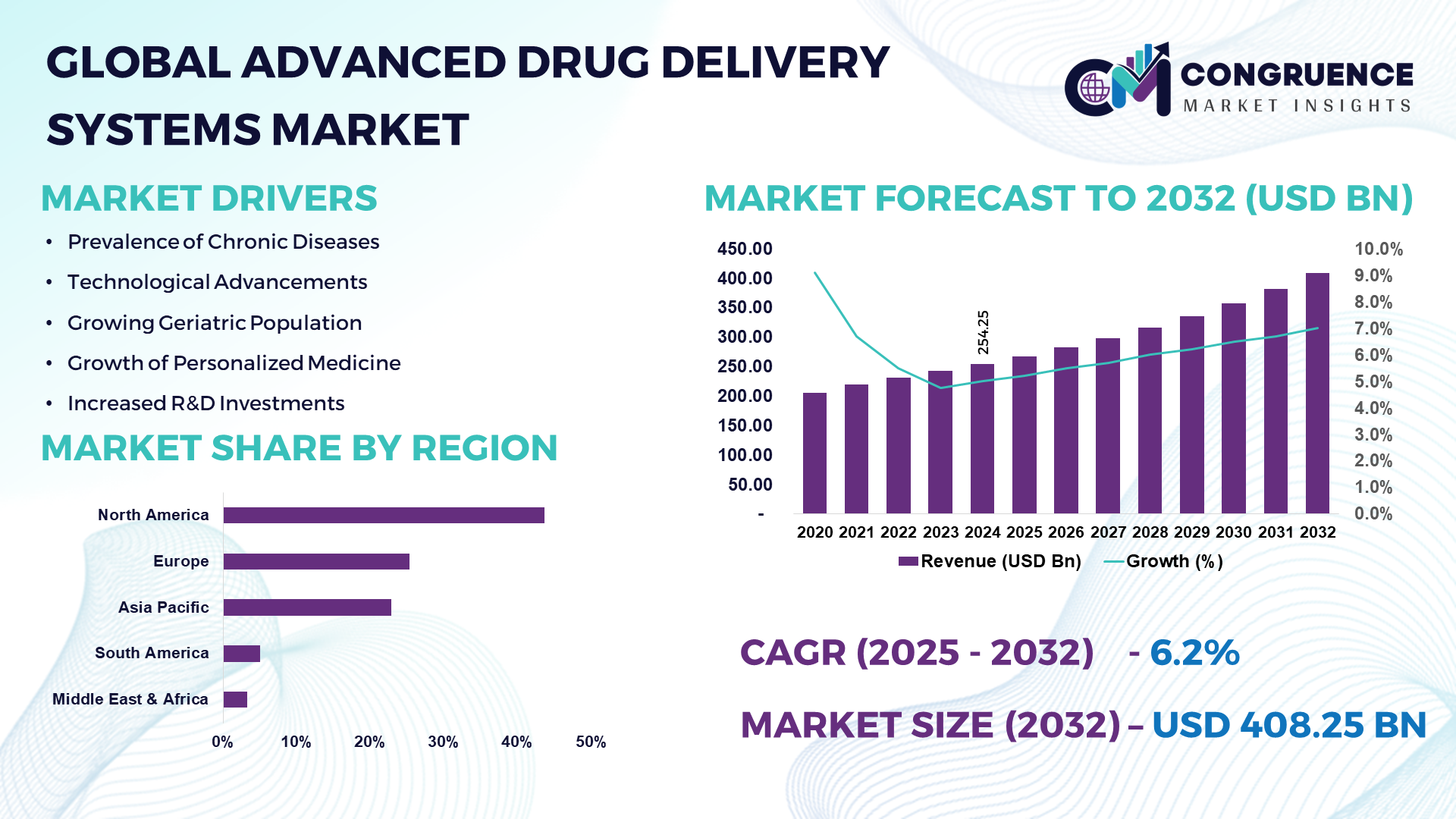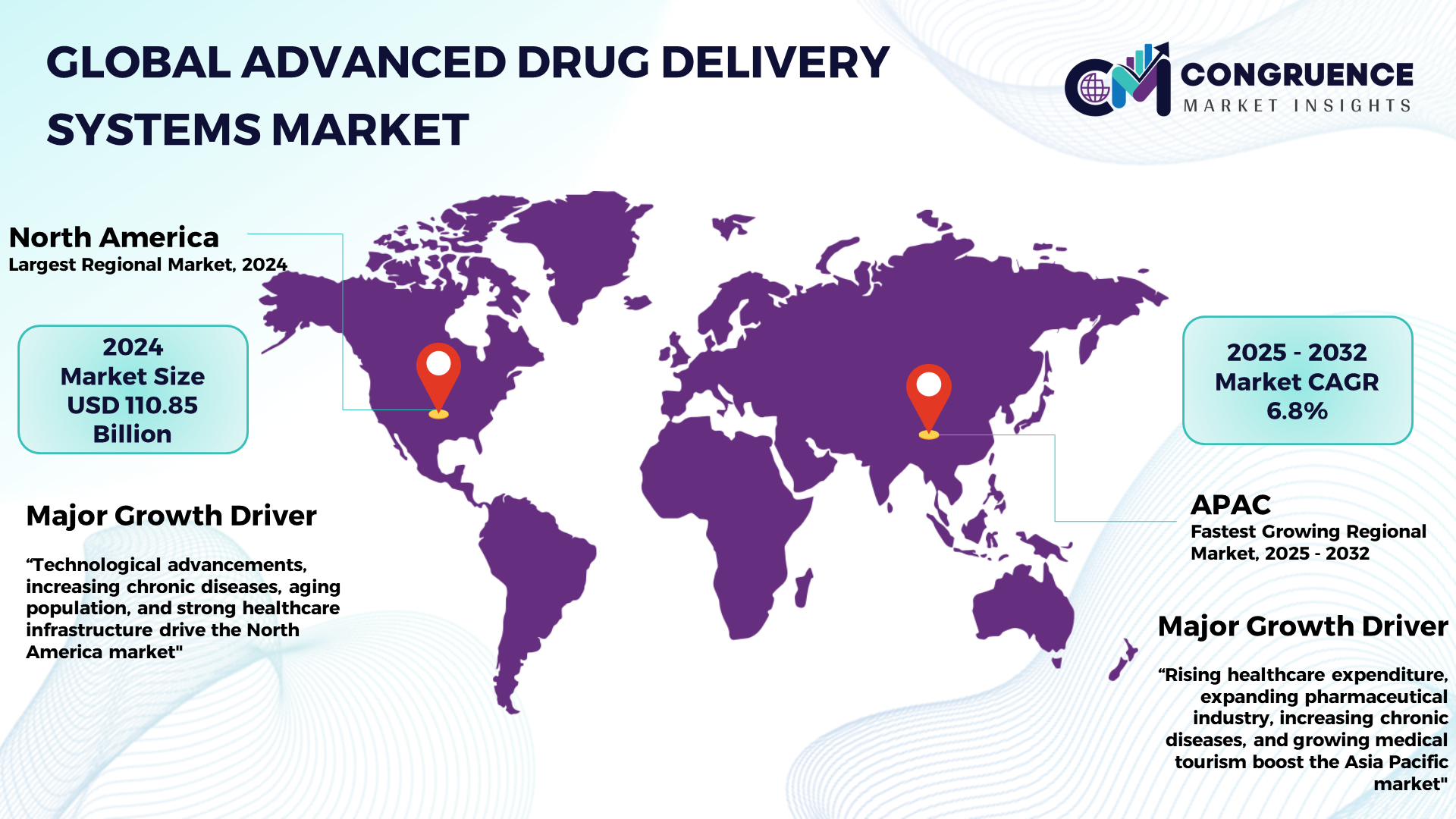Reports
Advanced Drug Delivery Systems Market Size and Forecast 2025 to 2032
The Global Advanced Drug Delivery Systems Market was valued at USD 254.25 Billion in 2024 and is anticipated to reach a value of USD 408.25 Billion by 2032 expanding at a CAGR of 6.2% between 2025 and 2032. One of the main causes of this growth is the growing need for novel drug delivery techniques brought on by the rising incidence of chronic illnesses such as diabetes and cancer.

To Learn More About This Report, Request A Free Sample Copy
The market for advanced drug delivery systems is crucial to contemporary healthcare because it makes it possible to deliver therapeutic medications in a controlled, effective, and targeted manner. By enhancing drug bioavailability, controlling release, and enabling site-specific targeting, these technologies enhance patient outcomes while reducing adverse effects. The need for improved drug delivery techniques has increased as chronic illnesses such as diabetes, cancer, and cardiovascular disease are becoming more prevalent globally. Pharmaceutical firms are actively focusing on technologies such as polymer-based systems, liposomes, and nanoparticles that increase the effectiveness of drug delivery. The market is expanding as a result of the increasing acceptance of personalized medicine, which calls for precise drug delivery tailored to the needs of specific patients. Additionally, it is anticipated that the need for innovative drug delivery systems will increase due to developments in biologics, such as gene therapy and monoclonal antibodies. The market is expected to grow as a result of regulatory approvals for upgraded systems and significant R&D expenditures by major rivals.
How AI is Transforming Advanced Drug Delivery Systems Market
By improving the accuracy and effectiveness of drug delivery methods, artificial intelligence (AI) is revolutionizing the market for advanced drug delivery systems. By reducing side effects and enhancing therapeutic results, AI algorithms assist in the development of delivery vehicles that are optimized for the efficient transportation of pharmaceuticals. With machine learning models, AI can forecast how drug formulations will behave in the body, enabling more precise dosage and controlled release according to the patient's unique physiological parameters. AI is also transforming drug development by accelerating the discovery of therapeutic candidates and delivery systems. Researchers can model and forecast drug interactions at the molecular level with AI-powered simulations, which shortens the R&D cycle and lowers costs. AI can also identify biomarkers that allow for more precise drug delivery, enhancing the accuracy of customized therapies.
AI is assisting in logistics by streamlining the supply chain for better medication delivery systems, guaranteeing on-time delivery, and removing waste. Additionally, it is used to ensure the safety and efficacy of drug delivery systems by continuously monitoring their performance. It is anticipated that as AI technologies develop, they will increasingly be integrated with drug delivery systems, leading to notable enhancements in patient outcomes and drug performance.
Advanced Drug Delivery Systems Market Major Driving Forces
· Prevalence of Chronic Diseases: One important factor is the increase in chronic conditions such as diabetes, cardiovascular disease, and cancer. Innovative delivery systems are becoming more and more necessary as patients with these diseases need new medications that are more effective and have fewer side effects.
· Technological Developments: More effective drug targeting and controlled release are made possible by developments in polymer-based delivery systems, liposomal drug delivery, and nanotechnology, which is propelling market growth.
· Growing Geriatric Population: Chronic illnesses are more prevalent as people age, which increases the need for specialized drug delivery systems that cater to the particular medical needs of this group.
· Personalized Medicine: The market is expanding as a result of the shift to personalized medicine, which calls for more targeted and specialized drug delivery systems. Modern delivery techniques offer the accuracy required to customize treatments for every patient.
· R&D Investments: Companies in the biotechnology and pharmaceutical industries are investing more in R&D, which is fostering innovation in drug delivery systems and accelerating market growth.
Advanced Drug Delivery Systems Market Key Opportunities
· Growth of Biologics: There are many opportunities for improved drug delivery systems in the expanding biologics industry, which includes gene therapies, monoclonal antibodies, and vaccines. To increase efficacy, biologics must be distributed precisely and precisely, opening the door for more sophisticated delivery systems.
· Nanotechnology-Based Delivery: There is a significant opportunity to develop drug delivery systems based on nanotechnology. Improved drug stability and customized distribution are made possible by nanoparticles, which may lead to better patient outcomes.
· Development in Emerging Countries: The healthcare systems in emerging countries, especially those in Asia Pacific and Latin America, are getting better very quickly. Government programs and higher healthcare spending are providing opportunities for these areas to implement advanced drug delivery systems.
· Collaborations and Partnerships: To develop novel drug delivery systems, technology companies and pharmaceutical companies are collaborating. Collaborations aimed at developing next-generation drug delivery systems have a great chance of becoming profitable.
Advanced Drug Delivery Systems Market Key Trends
· There is growing interest in creating systems that can deliver drugs straight to sick cells or tissues, reducing the possibility of side effects and boosting the effectiveness of treatment.
· More and more people are using sophisticated drug delivery systems that offer controlled and continuous release of pharmaceuticals. By ensuring that the medication is administered at the right time and dose, these technologies improve patient compliance.
· Because biodegradable polymers offer advantages such as reduced toxicity and enhanced patient safety, their use in drug delivery systems is expanding. Following the delivery of the therapeutic payload, these materials naturally break down inside the body.
· Drug delivery systems are integrating artificial intelligence (AI) and the Internet of Things (IoT) to enable real-time monitoring of drug delivery and patient reaction, producing data that could be used to enhance treatments.
Region-wise Market Insights
North America accounted for the largest market share at 43.6% in 2024 whereas, Asia Pacific is expected to register the fastest growth, expanding at a CAGR of 6.8% between 2025 and 2032.

To Learn More About This Report, Request A Free Sample Copy
The dominance in North America is a result of several factors, including the existence of a strong healthcare system, excellent R&D capabilities, and sizable pharmaceutical companies in both the US and Canada. The region's focus on personalized medicine and biologics strengthens its position in the market.
· In May 2024, Johnson & Johnson's Phase 3 PALOMA-3 study revealed a five-fold reduction in infusion-related reactions by administering amivantamab subcutaneously in just five minutes. This method shows significant improvement in patient convenience and safety compared to the standard intravenous method. These findings support further innovations in cancer treatment delivery.
However, with a CAGR of 6.8%, the Asia Pacific region is anticipated to grow at the fastest rate during the forecast period. The market is being driven by rising pharmaceutical R&D activities and healthcare investments in nations such as China, India, and Japan. Furthermore, the need for advanced drug delivery systems is rising as a result of government initiatives to upgrade healthcare infrastructure and the rising incidence of chronic diseases.
With a strong focus on regulatory compliance and an increasing use of cutting-edge technologies in healthcare, Europe is another important market. As healthcare access expands, there is a growing need for medication delivery options, which is driving up investment in pharmaceutical infrastructure in Latin America, the Middle East, and Africa.
Recent Developments
· In December 2024, Pfizer's AI initiatives have revolutionized drug discovery and personalized medicine. Leveraging machine learning and deep learning, Pfizer accelerates drug development, reduces trial costs, and tailors treatments based on individual genetic profiles. Their AI-driven approach enables faster approvals and enhances precision in treatments, exemplified by their rapid COVID-19 vaccine development.
· In July 2024, Roche reintroduced Susvimo® (ranibizumab injection) in the U.S. for neovascular age-related macular degeneration (nAMD), following FDA-approved updates after a voluntary recall. Susvimo, a refillable implant, offers continuous delivery of ranibizumab, reducing the need for frequent eye injections and improving vision preservation for nAMD patients.
· In August 2023, Janssen submitted a supplemental New Drug Application (sNDA) to the FDA for full approval of BALVERSA® (erdafitinib). The drug is intended for patients with locally advanced or metastatic urothelial carcinoma and specific FGFR gene alterations. This marks a step towards expanding treatment options for these patients.
· In June 2022, Novartis acquired Kedalion Therapeutics, along with its AcuStream™ technology, an innovative ocular drug delivery platform. This acquisition is expected to enhance Novartis' eye care portfolio by improving the precision and efficiency of ophthalmic treatments, offering better patient experiences for those needing eye medications.
Market Competition Landscape
In order to strengthen their market position, leading competitors in the fiercely competitive advanced drug delivery systems market prioritize innovation, mergers, and alliances. Among the leading companies are Merck & Co., Inc., Pfizer Inc., Roche Holding AG, Novartis AG, Bayer AG, and Johnson & Johnson. These companies are investing heavily in research and development to develop innovative drug delivery technologies, including systems based on nanotechnology, polymer drug delivery, and customized delivery techniques.
By offering specialized solutions such as liposomal and nanoparticle-based delivery methods, smaller biotech startups and specialized players are gaining traction alongside the major pharmaceutical companies. These companies usually collaborate with bigger pharmaceutical companies to jointly create and market cutting-edge delivery systems. In order to comply with legal requirements and environmental concerns, businesses are concentrating on biodegradable and environmentally friendly drug delivery technologies, which is another factor driving competition.
Key players in the global advanced drug delivery systems market implement various organic and inorganic strategies to strengthen and improve their market positioning. Prominent players in the market include:
· Johnson & Johnson
· Novartis AG
· Bayer AG
· Pfizer Inc.
· Roche Holding AG
· Merck & Co., Inc.
· GlaxoSmithKline PLC
· Sanofi
· AstraZeneca
· 3M Company
· Becton, Dickinson and Company
· Eli Lilly and Company
· Amgen Inc.
· Teva Pharmaceutical Industries Ltd.
|
Report Attribute/Metric |
Details |
|
Market Revenue in 2024 |
USD 254.25 Billion |
|
Market Revenue in 2032 |
USD 408.25 Billion |
|
CAGR (2025 – 2032) |
6.2% |
|
Base Year |
2024 |
|
Forecast Period |
2025 – 2032 |
|
Historical Data |
2020 to 2024 |
|
Forecast Unit |
Value (US$ Bn) |
|
Key Report Deliverable |
Revenue Forecast, Growth Trends, Market Dynamics, Segmental Overview, Regional and Country-wise Analysis, Competition Landscape |
|
Segments Covered |
· By Type (Oral Drug Delivery Systems, Injectable Drug Delivery Systems, Topical Drug Delivery Systems, Inhalation Drug Delivery Systems, and Ocular Drug Delivery Systems) · By Technology (Nanotechnology, Liposomal Delivery, Polymer Drug Delivery, Prodrug-based Delivery, and Targeted Delivery) · By Application (Oncology, Cardiovascular Diseases, Diabetes, Infectious Diseases, and Neurological Disorders) · By End-Use Industry (Pharmaceutical Companies, Biotechnology Companies, and Research Institutions) |
|
Geographies Covered |
North America: U.S., Canada and Mexico Europe: Germany, France, U.K., Italy, Spain, and Rest of Europe Asia Pacific: China, India, Japan, South Korea, Southeast Asia, and Rest of Asia Pacific South America: Brazil, Argentina, and Rest of Latin America Middle East & Africa: GCC Countries, South Africa, and Rest of Middle East & Africa |
|
Key Players Analyzed |
Johnson & Johnson, Novartis AG, Bayer AG, Pfizer Inc., Roche Holding AG, Merck & Co., Inc., GlaxoSmithKline PLC, Sanofi, AstraZeneca, 3M Company, Becton, Dickinson and Company, Eli Lilly and Company, Amgen Inc., Teva Pharmaceutical Industries Ltd. |
|
Customization & Pricing |
Available on Request (10% Customization is Free) |
